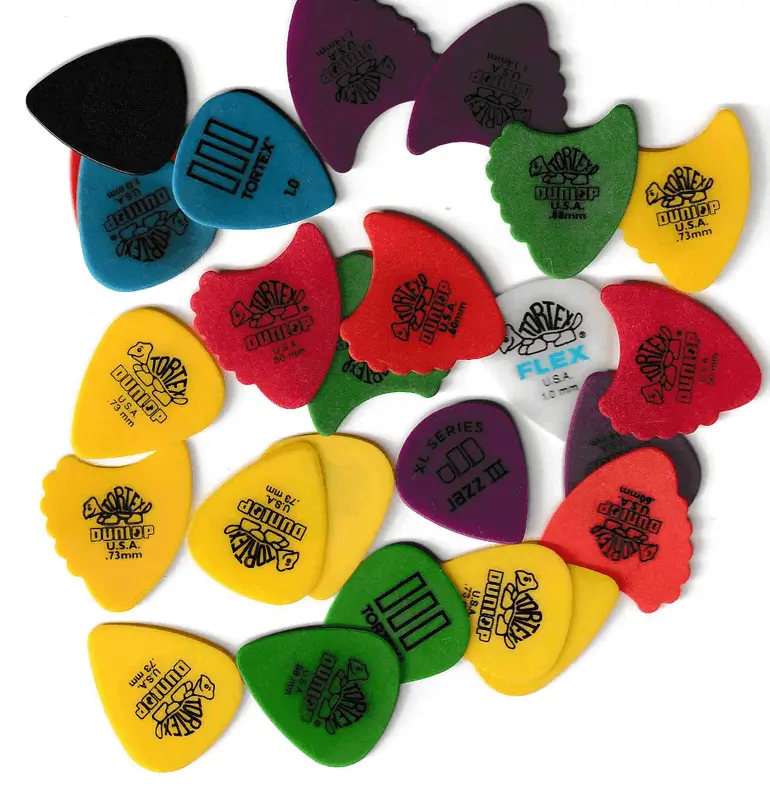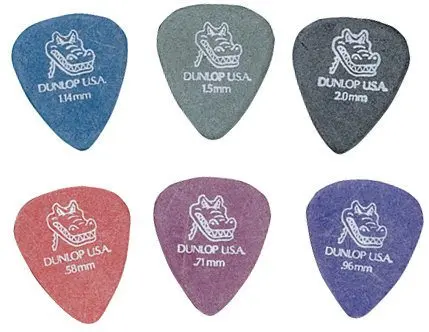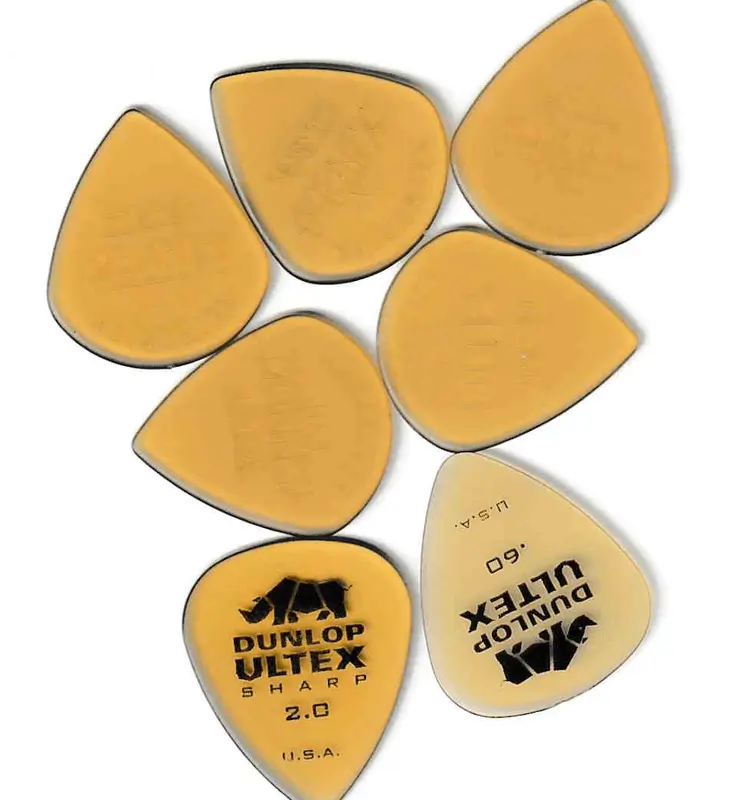This page is all about Dunlop’s Tortex, Gator-Grip, and Ultex Guitar Picks which are a branch of special plastics that all fit into a group. Pickfetish: Your website on electric/acoustic guitar picks covers these special materials.
Ok, so now, of all the plastic picks that are not Celluloid or Nylon, there are so many types, but: the Dunlop “Big Three” materials dominate the market. Read on…
These 3 materials are Acetal, Ultem, and “Delrex”, which cover the market, as named Dunlop’s Tortex, Gator-Grip, and Ultex Guitar Picks:
The Dunlop Brand “Big Three” plastic pick materials are covered here:
Expounding on this: I decided that it made sense to put these three in one section although they are different enough for players to matter. This is primarily because I wanted to group the massive list of various plastics in some type of “guitarist’s” logic. Dunlop’s Tortex, Gator Grip, and Tortex picks are, in my thoughts, and to guitarists and other musicians, a group of materials. They fit in a type of “class”.
These three materials are often used in production picks by other companies as well.
Dunlop makes picks out of these three materials, and so do a few other companies. Other outfits, such as some of your favorite dealers, have their own branding names of these three types. You can go to Fender, Gibson, Earnie Ball, heck, even Stringjoy, sells them, they are a popular fine string maker. In the future, I will review their picks soon.
Dunlops Tortex, Gator Grip, and Ultex are discussed individually here:
Acetal (pronounced ASS-Eht-ALL), take a look-see:

This material, one type of which is otherwise known as Delrin, is fairly hard plastic. Called a homopolymer it is a type of Acetal. Expounding on this, it has a hardness of about 76.5 On my Shore D Durometer. This is right in the neighborhood as many harder plastics, yet slightly softer than some of them. Furthermore, it’s a touch softer than Celluloid. It is an extremely popular material widely in use by many many players it is a reasonable replacement for Celluloid.
Something new, something better (than celluloid)?
Jim Dunlop wanted a “better” alternative to Tortoise Shell for picks than Celluloid. Whether or not it is better is subjective. It is more durable, but not as durable as other materials. It sounds good, but sounding good is a personal thing, what is good for you might not be for, who knows, SRV, EVH, or Santana. Each player must choose her or his weapon.
Delrin’s qualities:
It also has a matte-like surface that helps your grip. It is one of the most popular materials for many of the more serious musicians and has moderate flexibility when it comes to hard plastics. I expound: It flexes when in the sub 1mm thickness range, but it’s only a little bit until you get into a bit thinner dimensions.
As far as how it plays, there are debates as to what guitarists find as the better of this one and the following two. For me, it has a little darker, less flappy tone than the others which seems to be why it is so popular with players (and manufacturers).
On top of this, Acetal is a pretty common and often-used material and is probably more affordable to many makers in and out of the industry. My educated guess is part of its popularity is its availability and the sheer volume of its production in manufacturing. You can find these in every store that sells picks.
Some specs on Delrin
It is also known as “Acetal Homo-Polymer”
Where do we fit this ubiquitous material?
I would place plastics such as Delrin somewhere in between thicker Celluloid and Nylon picks as far as tone and utility.
Another advantage of these picks is that it’s more likely to find them in a store than most other non-nylon and non-celluloid picks. If you are a “road dog”: You playing endless street gigs, this will matter to you, especially if you lose picks frequently.
So there is a brief about Acetal, Dunlop’s Tortex, Gator Grip, and Ultex types, what about the other two?
The latter pick material I listed, is Delrex by Dunlop and is quite similar to Tortex. It is Delrin but with an added texture. My assumption is they process the polymer differently enough that the surface is different. I suspect additives are included. The brand line is “Gator Grip”. It is named aptly as it is more grippy. Furthermore, it has a slightly brighter and flappier tone print (or just a touch so, that is).

Gator Grip’s Selling Points:
Its selling point is that it is just a notch more easily held onto. It also offers a somewhat similar tone. The brand is Gator Grip by Jim Dunlop. All Gauges vary from Tortex slightly. Gator’s sheets come in a slightly thinner gauge, where the “Tortex” Delrin comes in 1.0mm, and the “Gator” comes in .96 mm. I imagine this is to get their natural flexibility more similar, but they still differ, this is stiffer.
You will find, however, that some other makers using similar materials offer slightly different thicknesses.
The specs then?
I tested the hardness being about 72-75H on my Durometer, a little bit softer than the first type I listed. Grasp matters and playing a generally bright guitar such as an S-type, you will love the Gator Grip Picks or their competitor’s product. One competitor is D’andrea and they use a slightly different thickness.
The next section of Dunlop’s Tortex Gator-Grip and Ultex picks is, well, the third type:
Moving on to the middle of the list’s plastic, Dunlop’s “Ultex”, or the factory name, “Ultem”. We see a different hardness and tone yet again. I tested it being about 82.5 Shore D HD.
The material is a type of PEI High-Temperature plastic that is often used in 3D printing.

These are more durable according to users, as the selling point, and the tone is about as warm as the Tortex Picks’ Delrin, perhaps a little crisper. It isn’t as flappy as the Gator material. Some swear by their durability as they don’t wear down nearly as quickly as the previous two types.
But what about the Grip and Wear?
I like the tone of these and furthermore, they sound good with humbucker guitars.
It is clearly a harder and more durable material with equally good sound but is a little less sure-to-the-grip. Also, it is made of a matte-like material that is somewhat slippery. Yellow-colored as pictured, it is unique.
So what is the tech behind Ultex then?
The material is Polyetherimide as shown on this plastics tech sheet page.
Polyetherimide has quite a bit less flexibility than the other two types above. Also, It has a slightly sharper tone, and the tips are a bit sharper as well, thanks to the material’s hardness.
Manufacturers add textures that are readily impressed into this poly-material. It helps us grip them somewhat, but: You may find that you want to use a grip substance with Ultex, and keep in mind that they are not as available in stores.
Nevertheless, they are highly popular. Some stores do stock them, so your mileage will vary.
<I have a review of various grip devices and materials to help you with holding on. Keep an eye out for it.>
In conclusion, I have hopes that:
I will post more information on these 3 plastics as I discover them. The salient thing about them is that they are all decent sounding and are a touch flappy (though not nearly as much as Nylon). With pros, they love these but beginners have to still learn to get used to them.
Now we go on to Translucent Plastic Picks.
How about you? Do you use these three or one of them or two of them? Give us a shout!

Drop a comment!